Abijah is a Biblical Hebrew unisex name which means "my Father is Yah". The Hebrew form Aviyahu also occurs in the Bible.
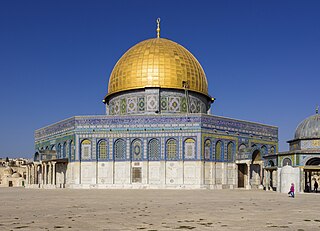
The Dome of the Rock is an Islamic shrine at the center of the Al-Aqsa mosque compound on the Temple Mount in the Old City of Jerusalem. It is the world's oldest surviving work of Islamic architecture, the earliest archaeologically attested religious structure to be built by a Muslim ruler and its inscriptions contain the earliest epigraphic proclamations of Islam and of the Islamic prophet Muhammad.

Zechariah is a Jewish figure in the New Testament and the Quran, and venerated in Christianity and Islam. In the Bible, he is the father of John the Baptist, a priest of the sons of Aaron in the Gospel of Luke, and the husband of Elizabeth who is a relative of the Virgin Mary.

The Mount of Olives or Mount Olivet is a mountain ridge in East Jerusalem, east of and adjacent to Jerusalem's Old City. It is named for the olive groves that once covered its slopes. The southern part of the mount was the Silwan necropolis, attributed to the elite of the ancient Kingdom of Judah. The western slopes of the mount, those facing Jerusalem, have been used as a Jewish cemetery for over 3,000 years and holds approximately 150,000 graves, making it central in the tradition of Jewish cemeteries. Atop the hill lies the Palestinian neighbourhood of At-Tur, a former village that is now part of East Jerusalem.
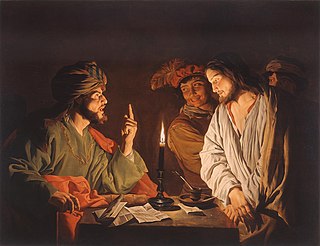
Joseph ben Caiaphas, known simply as Caiaphas in the New Testament, was the Jewish high priest during the years of Jesus' ministry, according to Josephus. The Gospels of Matthew, Luke and John indicate he was an organizer of the plot to kill Jesus. He famously presided over the Sanhedrin trial of Jesus. The primary sources for Caiaphas' life are the New Testament, and the writings of Josephus. The latter records he was made high priest by the Roman procurator Valerius Gratus after Simon ben Camithus had been deposed.

The Tomb of Absalom, also called Absalom's Pillar, is an ancient monumental rock-cut tomb with a conical roof located in the Kidron Valley in Jerusalem, a few metres from the Tomb of Zechariah and the Tomb of Benei Hezir. Although traditionally ascribed to Absalom, the rebellious son of King David of Israel, recent scholarship has dated it to the 1st century AD.

The Tomb of Zechariah is an ancient stone monument in Jerusalem that is considered in Jewish tradition to be the tomb of Zechariah ben Jehoiada. It is a few meters from the Tomb of Absalom and adjacent to the Tomb of Benei Hezir.

Ramat Eshkol is an Israeli settlement and neighborhood in northern East Jerusalem. It was built on land captured from Jordan in the Six-Day War and occupied by Israel since 1967, and was the first settlement built in East Jerusalem beyond the Green Line by Israel. The international community considers Israeli settlements in East Jerusalem illegal under international law, but the Israeli government disputes this. As of 2017, about 8,975 people live in the neighborhood.
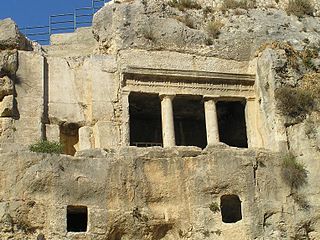
The Tomb of Benei Hezir, previously known as the Tomb of Saint James, is the oldest of four monumental rock-cut tombs that stand in the Kidron Valley, adjacent to the Tomb of Zechariah and a few meters from the Tomb of Absalom. It dates to the period of the Second Temple. It is a complex of burial caves. The tomb was originally accessed from a single rock-cut stairwell which descends to the tomb from the north. At a later period an additional entrance was created by quarrying a tunnel from the courtyard of the monument known as "the Tomb of Zechariah". This is also the contemporary entrance to the burial complex.
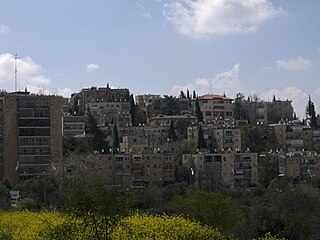
Kiryat Shmuel is a neighborhood in central West Jerusalem founded in 1926. It is named for Rabbi Shmuel Salant, the Ashkenazi Chief Rabbi of Jerusalem in 1878–1909. Kiryat Shmuel is located between Rehavia and Katamon.

The Monolith of Silwan, also known as the Tomb of Pharaoh's Daughter, is a cuboid rock-cut tomb located in the Kidron Valley, in Silwan, Jerusalem dating from the period of the Kingdom of Judah. The Tomb of Pharaoh's Daughter refers to a 19th-century hypothesis that the tomb was built by Solomon for his wife, the Pharaoh's daughter. The structure, a typical Israelite rock-cut tomb, was previously capped by a pyramid structure like the Tomb of Zechariah. The upper edges of the monolith are fashioned in the shape of an Egyptian cornice. The pyramidal rock cap was cut into pieces and removed for quarry during the Roman era, leaving a flat roof. The tomb contains a single stone bench, indicating that it was designed for only one burial. Recent research indicates that the bench was the base of a sarcophagus hewn into the original building.

The Chapel of Saint Helena is a 12th-century Armenian church in the lower level of the Church of the Holy Sepulchre in Jerusalem, constructed during the Kingdom of Jerusalem. The Armenians call it the Chapel of St. Gregory the Illuminator, after the saint who brought Christianity to the Armenians.

Jason's Tomb is a rock-cut tomb dating to the first century BCE in the Hasmonean period, discovered in the Rehavia neighborhood in Jerusalem, Israel. It has been identified as the burial site of a certain Jason, possibly a naval commander, based on the charcoal drawing of two warships discovered in the cave.

The Caiaphas ossuary is one of twelve ossuaries or bone boxes, discovered in a burial cave in south Jerusalem in November 1990, two of which featured the name "Caiaphas".

The Cave of Nicanor is an ancient burial cave located on Mount Scopus in Jerusalem. Among the ossuaries discovered in the cave is one with an inscription referring to "Nicanor the door maker". The cave is located in the National Botanic Garden of Israel on the grounds of the Mount Scopus campus of the Hebrew University of Jerusalem.

The triumphal entry into Jerusalem is a narrative in the four canonical Gospels describing the arrival of Jesus in Jerusalem a few days before his crucifixion. This event is celebrated each year by Christians on Palm Sunday.
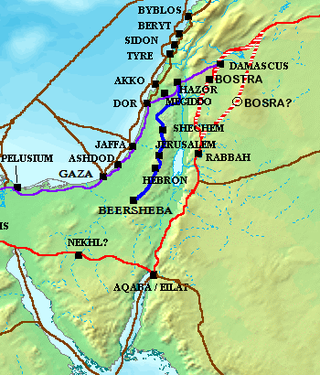
The Road of the Patriarchs or Way of the Patriarchs is an ancient north–south route traversing the land of Israel and the region of Palestine. The modern Highway 60 (Israel-Palestine) follows roughly the route of the Way of the Patriarchs. The name is used by biblical scholars because of mentions in biblical narratives that it was frequently travelled by Abraham, Isaac and Jacob.

Azal (אצל), or Azel, is a location mentioned in the Book of Zechariah 14:5, in Bibles that use the Hebrew Masoretic Text as the source for this verse. In Bibles that follow the Greek Septuagint (LXX) rendering, depending upon the source manuscript used, Azal is transcribed Jasol, Jasod, or Asael (ασαηλ):
And ye shall flee to the valley of the mountains; for the valley of the mountains shall reach unto Azal: yea, ye shall flee, like as ye fled from before the earthquake in the days of Uzziah king of Judah.
The valley between the hills will be filled in, yes, it will be blocked as far as Jasol, it will be filled in as it was by the earthquake in the days of Uzziah king of Judah,
Miriam ossuary is a decorated limestone ossuary from a tomb in the Valley of Elah, Israel, which bears an inscription attributing it to "Miriam, the daughter of Yeshua."

The Western Wall Plaza is a large public square situated adjacent to the Western Wall in the Jewish Quarter of the Old City of Jerusalem. It was formed in 1967 as a result of the razing of the Mughrabi Quarter neighborhood at the very end of the Six-Day War.


















